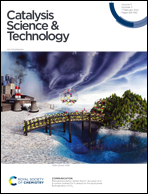Regeneration mechanism of a deactivated zeolite-supported catalyst for the combustion of chlorinated volatile organic compounds†
Abstract
Industrial catalysis is confronted with the common problem of catalyst deactivation. For the field of chlorinated volatile organic compound (Cl-VOC) elimination, it is hard to find an effective solution for the regeneration and re-use of deactivated catalysts within industrial settings. In this work, the performance of a metal-exchanged H-zeolite (Cu–Nb/HZSM-5) catalyst is tested for chlorobenzene (CB) combustion by different catalyst regeneration strategy. By confirming the related reaction mechanism via in situ DRIFTS, GC-MS, and PR-IR, the catalysts were analyzed in terms of their carbon deposition, surface elemental content, and acidity, before and after the regeneration. It was found that humid air exhibited an excellent catalyst restoration effect at a temperature of 400 °C, the adsorbed coke and chlorine on the surface of the deactivated catalyst were mostly removed, and the catalytic performance was recovered to 100% of that of the fresh catalyst.



 Please wait while we load your content...
Please wait while we load your content...